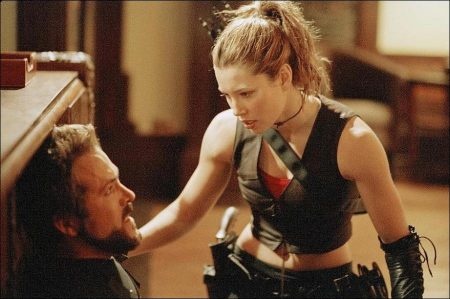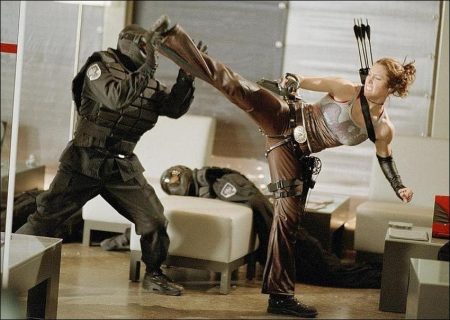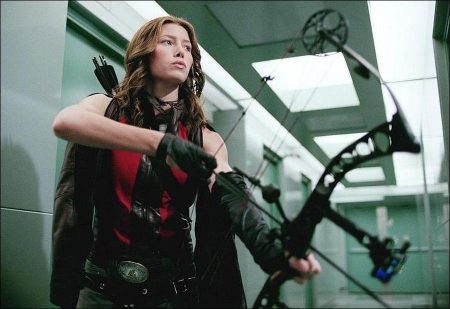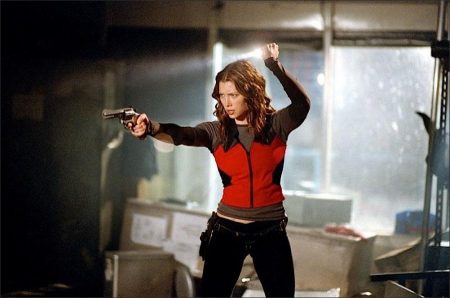About the Film
Following the initial 1998 hit Blade, the 2002 sequel Blade 2 went on to achieve even greater box office success. Blade: Trinity brings back the Daywalker Blade to face the greatest challenge of his vampire-fighting career.
David S. Goyer, who has written the screenplays for all three films in the Blade franchise and also takes on the role of director for Blade: Trinity, offers his take on the continuing success of the series and why audiences so enthusiastically keep coming back for more.
“The Blade films have always had a certain kind of artistic integrity. They’re true to themselves. They’re dark and often unremitting. The first movie came at a time when people were used to seeing more polished superhero films, more polished films in general. People were ready to see something that was a little grittier, a little more in your face. The Blade films are also very stylish in their own way. They’ve been very influential with regards to other films and certainly plenty of television shows.”
As for Goyer’s own fascination in continuing to write about the Blade character, he confides that he is entranced by characters that are more or less at war with themselves. “I’m always drawn to antiheroes. And within the realm of the Marvel Comics-based films and comic book movies in general, Blade is about as dark a character as they get. He is a hero in spite of himself, but he’s a conflicted hero and not even a particularly nice guy.”
“In the same way that Clint Eastwood’s character in Unforgiven is a very conflicted character,” Goyer continues, “Blade is also forced into a position where he ends up doing something for the benefit of humanity, but humanity doesn’t really care about the fact that he helped them out. I always find those kind of characters interesting.”
For the latest chapter, Goyer has created two interweaving story lines, both of them presenting serious obstacles for Blade to overcome. “The first is that the vampires have decided to out Blade and they’ve effectively framed him so that the FBI and the local police are also hunting him, actually doing the vampires’ work for them,” says Goyer. “When the FBI eventually capture Blade, he’s forced to accept the help of Hannibal King and Abigail Whistler, who are members of another vampire hunting organization called the Nightstalkers. And they become Blade’s new allies for the third film.”
“At the same time,” continues Goyer, “what the vampires are trying to do is resurrect the king of the vampires, the progenitor of the vampire race, a character called Drake, who has been around for about seven thousand years. He’s the character who has spawned the Dracula myths. But he’s a much older character than that, and he is able to exist in daylight, like Blade. The vampires are bringing him back because they hope that through his genetic imprint, they can make themselves immune to sunlight. The notion is that over the last seven thousand years, the vampire bloodline is not as pure as they believe it to be. The reason they’ve lost the ability to go out in the sun is because they have crossbred with humans.”
Producer Peter Frankfurt elaborates further on the evolution of the Nightstalkers. “The Nightstalkers are a guerilla band of humans who know what is going on. Hannibal King was someone who had been attacked and converted to vampirism and was then able to cure himself. Because he crossed back from being a vampire, he has a real dedication to stamping them out. Abigail’s never been a vampire, but she had to cope with what happened to her father and the rest of her family.”
A unique aspect of the Blade trilogy is that the stories are deliberately set in the ‘real’ world, as Goyer explains. “To a certain degree we have tried in the Blade films to adhere to some kind of parameters of reality. So we’ve tried to explain how vampirism works by more scientific means. It’s not supernaturally induced but is actually a virus that progressively mutates the body and turns the subjects into another life form. Vampires are essentially another species. They can procreate. They’re not undead. Of course we still play a little fast and loose with the rules of reality!”
Pitting a character like Blade against the authorities of the modern world makes for some interesting possibilities, as Goyer details. “In Blade: Trinity we are saying ‘what would happen if vampires really existed in our world? And how would the FBI react to a character like Blade?’ Because our world doesn’t understand that vampires exist, someone like Blade comes across as a complete psychopath. And because every time he kills a vampire, they don’t leave a body – they ash – there’s very little evidence that all these crazy claims he’s making are really true.”
“We’ve tried to make each film very different,” producer Lynn Harris explains. “One of the strengths of the first Blade was that it was set in the real world, but Trinity goes much further than the original in terms of style and in terms of being set in ‘reality.’ “
Harris points out some key developments in the storyline which differentiate Blade: Trinity from its two predecessors. “Blade is now a known character to the police, the FBI and the news media. In the first movie he was still underground. Also, Blade 2 was much more creature effects-oriented, and in Blade: Trinity, while there certainly are some creature effects, we’re more centered in the world of action and martial arts. We also have some fascinating new weapons.”
Producer Peter Frankfurt elaborates further on some of the contrasting elements between Blade: Trinity and it’s predecessors. “The second movie kind of went underground and became more stylized, more unto itself. This movie aims to go back into the world, to feel looser in almost a documentary style, as if we’re catching fragments of a war and its spilling onto the streets. Our cinematographer Gabriel Beristain also shot Blade 2, and one of the reasons he was excited to come back was to work with David Goyer and also because what we wanted to do was so completely different from the previous film. So he really gets to stretch and try different things.”
Blade: Trinity also emerges as the most character-driven of the trilogy, as Frankfurt points out. “Although Blade: Trinity has the best storyline, it’s really not about the plot so much as the new characters who are introduced. Abigail Whistler and Hannibal King are very different and extremely cool additions to the Blade universe. And it’s fun because they’ll defy audience expectations. They’ll be a surprise. And it’s also fun because they defy Blade’s expectations. Blade doesn’t really know how to deal with them in the movie, and that’s an amusing thing to watch.”
The fact that writer David Goyer has taken the reins as director is a logical development, as producer Lynn Harris explains. “After all, it was David who, along with Wesley Snipes, invented this franchise. He wrote all three scripts and there has never been another writer for the films, so he knows this franchise inside and out. Obviously Wesley contributes enormously to the character, but who better than the guy who started this to continue it?”
“It’s been an interesting progression because when I first pitched Blade, I actually pitched all three movies,“ David Goyer recalls while describing his growing involvement in the creation of the franchise. “On the first film I was the writer, on the second I was writer and producer, and now with the third film I’m writer, producer and director.”
Goyer has also taken on the daunting task of accelerating the momentum created by the first two successful films. “It’s a challenge because we’re in the third installment and we have to keep topping ourselves,” Goyer admits. Giving a further example of what makes this third film stand out from its predecessors, the director adds “this film has much more humor than the first two and that was a very conscious choice. By now Blade has dispensed with his angst and is ready to move on. There is a lot more dark humor and, although it’s never slapstick, people will be surprised at just how funny this movie is.”
Blade: Trinity also provides Goyer the opportunity to include several scenes, which didn’t make it into the first two films. “There were scenes that got cut, for one reason or another. One of them was a scene that was cut from the first film that appears on the DVD in the deleted scenes, in a very truncated version, and answers the question ‘if the vampires win, where will they get their food supply?’
This time we were able to do it in the way I originally envisioned, in a much more bombastic way, and I think audiences will be satisfied with that. The second big thing was an enormous chase sequence planned for Blade 2 that was cut for budgetary reasons. This time we took the entire 8-page sequence and did all of it the way that I intended for the second film.”
Blade: Trinity boasts the most eclectic and wide-reaching ensemble cast of the trilogy. In explaining the inspiration behind some of his casting choices, David Goyer cites his personal taste in films. “I enjoy a lot of indie and foreign films and I really wanted to populate the cast with a variety of independent films stars. It’s going to make for a nice juxtaposition. I’m just delighted with the cast and think it is by far the best that we’ve had.”
With such stars as Jessica Biel, Ryan Reynolds, Parker Posey, Natasha Lyonne and professional WWE wrestler Triple H added to the mix, there’s every likelihood that the film may appeal to an even broader audience. “I think it’s the most diverse cast we’ve ever had in a Blade movie,” producer Lynn Harris says. “Thanks to Triple H and Ryan and Jessica, I think we’ll be pulling in some ‘new blood,’ so to speak, in addition to the fans we’ve always had.”
There is one important element that defines the Blade franchise, as producer Peter Frankfurt explains. “The unifying common thread is of course Wesley Snipes as Blade. He’s so distinctive in his look and his bearing, and that doesn’t change, no matter what the palate is, no matter what the film stock is, what the frame rate is. He’s still Blade.”
There is no doubt in anyone’s mind that Wesley Snipes is the quintessential Blade. David Goyer recalls the early days of the development process. “When I first pitched the idea of doing a Blade movie, the studio felt there were only three actors who could possibly do the role: Wesley Snipes, Denzel Washington and Lawrence Fishburne. But in my mind, Wesley was always the perfect Blade. So when I was writing the first film, he was whom I pictured. Because he’s so well trained in martial arts, it comes to him naturally. He has an innate understanding of action and movement and dance. But he’s also a classically trained actor. And even though Blade is a man of few words, Wesley imbues him with all these beautiful little nuances. “
Describing the working process between he and Snipes, Goyer adds that “usually what happens when Wesley and I sit down and go through the first draft of a script, is that we end up cutting even more of Blade’s lines. And it’s always a challenge to try to have Blade speak as little as possible in the first act. And it takes a talented actor to be able to pull that off, and not have the character come across as wooden or just like an animated action figure.”
Wesley Snipes describes the evolution of his character, who reaches the apex of his vampire-fighting career in Blade: Trinity. “Blade finds himself face to face with his destiny as he encounters the vampire of all vampires. It is his most difficult challenge yet.”
A real life challenge, as Snipes explains, is to maintain audience fascination with the third installment of the franchise. “It’s a little demanding because we are trying to top ourselves, trying to give the audience more than we gave them previously, trying to be more creative and less repetitive. It requires a little more attention and focus because we have to dig a little deeper.”
Snipes acknowledges the importance of being able to meet the audience expectations of the richly detailed stories associated with the Blade franchise. “The audience wants that detail – the comic books have it, especially the successful ones, “ Snipes explains. “We can mimic that if we take the time to pay attention to the details. We don’t want to leave them short on anything.” Jessica Biel, who joins the series as Whistler’s daughter Abigail, one of the chief members of the Nightstalkers, was attracted to the project because she was a big fan of the original Blade and found the new developments in the storyline intriguing.
“It’s great that Blade has joined forces with other people who are on his team, who are helping and who are of almost the same caliber as he is,” says Biel. “And I thought that was really interesting. And I liked it that we were dealing with the Dracula. It wasn’t just another vampire. It was the number one vampire who started it all. What I liked about my character is that she was Whistler’s daughter, which made her just super cool. Whistler taught Blade everything he knows, so she comes from a really tough background.”
Biel also garners considerable respect for her acting abilities. “Jessica has an amazing intensity and the camera just loves her,” David Goyer enthuses. ”Her character is a woman of very few words. So she has to imbue that character with a lot of physicality and a lot of presence. It’s something that’s very difficult to do and she does it very well. She completely owns the scenes that she’s in and she definitely gives Wesley a run for his money.”
“Jessica Biel is a perfect human being,” producer Peter Frankfurt interjects. “She’s completely gorgeous. She is funny as hell. She’s a gifted actress and athlete, totally dedicated. She is fabulous in the fight sequences. She’s also completely drop dead beautiful, sexy and funny.”
Blade: Trinity (2004)
Directed by: David S. Goyer
Starring: Wesley Snipes, Kris Kristofferson, Jessica Biel, Dominic Purcell, Ryan Reynolds, Parker Posey, Ashley Scott, Steve Braun, John Michael Higgins, Natasha Lyonne
Screenplay by: David S. Goyer
Production Design by: Lucrezia Casta, Chris Gorak
Cinematography by: Gabriel Beristain
Film Editing by: Conrad Smart, Howard E. Smith
Costume Design by: Laura Jean Shannon
Set Decoration by: Jamie Jonasson, Tedd Kuchera
Art Direction by: Patrick Banister, Eric Fraser
Music by: Ramin Djawadi, RZA
MPAA Rating: R for strong pervasive violence and language, and some sexual content.
Distributed by: New Line Cinema
Release Date: December 8, 2004
Views: 202







